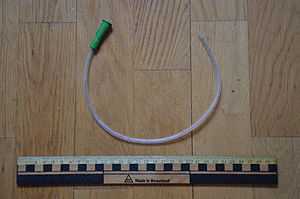Catheter




In medicine, a catheter /ˈkæθɪtər/ is a thin tube extruded from medical grade materials serving a broad range of functions. Catheters are medical devices that can be inserted in the body to treat diseases or perform a surgical procedure. By modifying the material or adjusting the way catheters are manufactured, it is possible to tailor catheters for cardiovascular, urological, gastrointestinal, neurovascular, and ophthalmic applications.
Catheters can be inserted into a body cavity, duct, or vessel. Functionally, they allow drainage, administration of fluids or gases, access by surgical instruments, and also perform a wide variety of other tasks depending on the type of catheter.[1] The process of inserting a catheter is catheterization. In most uses, catheter is a thin, flexible tube ("soft" catheter) though catheters are available in varying levels of stiffness depending on the application. A catheter left inside the body, either temporarily or permanently, may be referred to as an indwelling catheter. A permanently inserted catheter may be referred to as a permcath (originally a trademark).
The ancient Syrians created catheters from reeds. "Katheter — καθετήρ" originally referred to an instrument that was inserted such as a plug. The word "katheter" in turn came from "kathiemai — καθίεμαι" meaning "to sit". The ancient Greeks inserted a hollow metal tube through the urethra into the bladder to empty it and the tube came to be known as a "katheter".
Uses
Placement of a catheter into a particular part of the body may allow:
- draining urine from the urinary bladder as in urinary catheterization, e.g., the intermittent catheters or Foley catheter or even when the urethra is damaged as in suprapubic catheterisation.
- drainage of urine from the kidney by percutaneous (through the skin) nephrostomy
- drainage of fluid collections, e.g. an abdominal abscess
- administration of intravenous fluids, medication or parenteral nutrition with a peripheral venous catheter
- angioplasty, angiography, balloon septostomy, balloon sinuplasty, cardiac electrophysiology testing, catheter ablation. Often the Seldinger technique is used.
- direct measurement of blood pressure in an artery or vein
- direct measurement of intracranial pressure
- administration of anaesthetic medication into the epidural space, the subarachnoid space, or around a major nerve bundle such as the brachial plexus
- administration of oxygen, volatile anesthetic agents, and other breathing gases into the lungs using a tracheal tube
- subcutaneous administration of insulin or other medications, with the use of an infusion set and insulin pump
- A central venous catheter is a conduit for giving drugs or fluids into a large-bore catheter positioned either in a vein near the heart or just inside the atrium.
- A Swan-Ganz catheter is a special type of catheter placed into the pulmonary artery for measuring pressures in the heart.
- An embryo transfer catheter is designed to insert fertilized embryos from in vitro fertilization into the uterus. They may vary in length from approximately 150 mm to 190 mm.
- An umbilical line is a catheter used in Neonatal Intensive Care Units (NICU) providing quick access to the central circulation of premature infants.
- A Tuohy-Borst adapter is a medical device used for attaching catheters to various other devices.
- A Quinton catheter is a double or triple lumen, external catheter used for hemodialysis.
- An intrauterine catheter, such as a device known as a 'tom cat', may be used to insert specially 'washed' sperm directly into the uterus in artificial insemination. A physician is required to administer this procedure.
Inventors
The earliest American invention of the flexible catheter was during the 18th century. Extending his inventiveness to his family's medical problems, Benjamin Franklin invented the flexible catheter in 1752 when his brother John suffered from bladder stones. Franklin's catheter was made of metal with segments hinged together with a wire enclosed to provide rigidity during insertion.[2][3]
According to a footnote in his letter in Volume 4 of the Papers of Benjamin Franklin (1959), Benjamin Franklin credits Francesco Roncelli-Pardino from 1720 as the inventor of a flexible catheter. In fact, Benjamin Franklin claims the flexible catheter may have been designed even earlier[4]
An early modern application of the catheter was employed by Claude Bernard for the purpose of cardiac catheterization in 1844. The procedure involved entering a horse’s ventricles via the jugular vein and carotid artery. This appears to be an earlier and modern application of the catheter because this catheter approach technique is still performed by neurosurgeons, cardiologists, and cardiothoracic surgeons[5]
David S. Sheridan was the inventor of the modern disposable catheter in the 1940s. In his lifetime he started and sold four catheter companies and was dubbed the "Catheter King" by Forbes Magazine in 1988. He is also credited with the invention of the modern "disposable" plastic endotracheal tube now used routinely in surgery. Prior to his invention, red rubber tubes were used, sterilized, and then re-used, which had a high risk of infection and thus often led to the spread of disease. As a result Mr Sheridan is credited with saving thousands of lives.
In the early 1900s, a Dubliner named Walsh and a famous Scottish urinologist called Norman Gibbon teamed together to create the standard catheter used in hospitals today. Named after the two creators, it was called the Gibbon-Walsh catheter. The Gibbon and the Walsh catheters have been described and their advantages over other catheters shown. The Walsh catheter is particularly useful after prostatectomy for it drains the bladder without infection or clot retention. The Gibbon catheter has largely obviated the necessity of performing emergency prostatectomy. It is also very useful in cases of urethral fistula. A simple procedure such as dilatation of the urethra and passage of a Gibbon catheter often causes the fistula to close. This catheter is also of use in the treatment of urethral stricture and, as a temporary measure, in the treatment of retention of urine caused by carcinoma of the prostate.
Materials
A range of polymers are used for the construction of catheters, including silicone rubber, nitinol, nylon, polyurethane, and polyethylene terephthalate (PETE) latex, and thermoplastic elastomers. Silicone is one of the most common choices because it is inert and unreactive to body fluids and a range of medical fluids with which it might come into contact. On the other hand, the polymer is weak mechanically, and a number of serious fractures have occurred in catheters[citation needed]. For example, silicone is used in Foley catheters where fractures have been reported, often requiring surgery to remove the tip left in the bladder.
There are many different types of catheters for bladder problems. A typical modern intermittent catheter is made from polyurethane and comes in different lengths and sizes for men, women and children. The most advanced catheters have a thin hydrophilic surface coating. When immersed in water this coating swells to a smooth, slippery film making the catheter safer and more comfortable to insert. Some catheters are packed in a sterile saline solution.
Interventional procedures
Different catheter tips can be used to guide the catheter into the target vessel. Refer to[6] for a picture of different catheter tips and their respective names.
See also
|
References
- ↑ Diggery, Robert (2012). Catheters: Types, applications and potential complications (medical devices and equipment). Nova Science. ISBN 1621006301.
- ↑ "Benjamin Franklin: In Search of a Better World". Minnesota Historical Society.
- ↑ Hirschmann, J.V. (December 2005). "Benjamin Franklin and Medicine" (PDF). Annals of Internal Medicine 143 (11): 830–4. doi:10.7326/0003-4819-143-11-200512060-00012.
- ↑ Huth, E.J. (2007). "Benjamin Franklin's place in the history of medicine" (PDF). Journal of the Royal College of Physicians of Edinburgh 37 (4): 373–8.
- ↑ Baim, Donald (2005). Grossman's Cardiac Catheterization, Angiography, and Intervention. Lippincott Williams & Wilkins. ISBN 978-0781755672.
- ↑ http://www.merit.com/PDFs/IMPRESS400741001-B.pdf
External links
| Wikimedia Commons has media related to Catheters. |
- Millward, Steven F. (September 2000). "Percutaneous Nephrostomy: A Practical Approach". Journal of Vascular and Interventional Radiology 11 (8): 955–964. doi:10.1016/S1051-0443(07)61322-0.
https://commons.wikimedia.org/wiki/Category:Suprapubic_Catheters